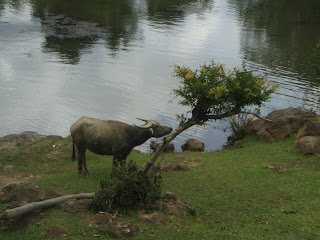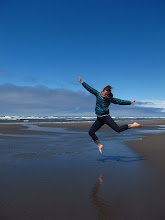
Rice sausage. And 7 Eleven. We must be back in Thailand!
 Yet another waterfall in the Bolevan for your viewing pleasure.
Yet another waterfall in the Bolevan for your viewing pleasure. This sunset was particularly relaxing after driving for 150km in the Bolaven. The area that we stayed in was very remote and beautiful, with jungle covered hills all around the rice fields in the valleys.
This sunset was particularly relaxing after driving for 150km in the Bolaven. The area that we stayed in was very remote and beautiful, with jungle covered hills all around the rice fields in the valleys. Amanda zipping down a dirt road on the Bolaven. We rented a motorbike for three days from Pakse, the provincal capital, and drove about 350km around the highlands here. This is where the majority of Laos' coffee comes from, which is in turn where most of the coffee in SE Asia originates.
Amanda zipping down a dirt road on the Bolaven. We rented a motorbike for three days from Pakse, the provincal capital, and drove about 350km around the highlands here. This is where the majority of Laos' coffee comes from, which is in turn where most of the coffee in SE Asia originates.  Amanda fashioned an umbrella out of a leaf to hide from the spray of a waterfall on the Bolaven Plateau. There were many waterfalls in this area, but this one was particularly breathtaking, with a huge drop into a churning pool below. We climbed down to the water's edge and scrambled through a cave there, where we could see a perfectly circular rainbow.
Amanda fashioned an umbrella out of a leaf to hide from the spray of a waterfall on the Bolaven Plateau. There were many waterfalls in this area, but this one was particularly breathtaking, with a huge drop into a churning pool below. We climbed down to the water's edge and scrambled through a cave there, where we could see a perfectly circular rainbow. A local girl leads a water buffalo from his wallowing grounds in the Mekong. The point that they are heading from is supposedly a favorite haunt of Irriwaddy Dolphins, which are extremely endangered. We tried our luck at getting a peak, but instead spent about 40 minutes gazing at Cambodia in the distance.
A local girl leads a water buffalo from his wallowing grounds in the Mekong. The point that they are heading from is supposedly a favorite haunt of Irriwaddy Dolphins, which are extremely endangered. We tried our luck at getting a peak, but instead spent about 40 minutes gazing at Cambodia in the distance. Li Phi falls on Don Khon in 4,000 Islands. This massive waterfall was lined with fishing weirs at every rapid that the locals use to gather up tons of fish. This waterfall and many others around Si Phan Don were also an important historical factor in the region. The French couldn't get their ships past them to get at the many resources in Laos. To get around this, the French did build a short railway line in Don Khon (the only tracks they ever laid in Laos), which is now defunct.
Li Phi falls on Don Khon in 4,000 Islands. This massive waterfall was lined with fishing weirs at every rapid that the locals use to gather up tons of fish. This waterfall and many others around Si Phan Don were also an important historical factor in the region. The French couldn't get their ships past them to get at the many resources in Laos. To get around this, the French did build a short railway line in Don Khon (the only tracks they ever laid in Laos), which is now defunct. Fabled Si Phan Don, or 4,000 islands, set in the widest stretch of the Mekong which spans 14KM at this point. The community here is still reliant on fishing, although tourism is booming and has been prevelant for many years. Rickety bungalows line the river front for bargian prices (we paid $1.90/night) although many of them aren't that stable. Ours was lofted about 25 feet over the water and shook when you walked around.
Fabled Si Phan Don, or 4,000 islands, set in the widest stretch of the Mekong which spans 14KM at this point. The community here is still reliant on fishing, although tourism is booming and has been prevelant for many years. Rickety bungalows line the river front for bargian prices (we paid $1.90/night) although many of them aren't that stable. Ours was lofted about 25 feet over the water and shook when you walked around. Temple gaurdian at Wat Phu Champasak. The site was a pre-Angkorian temple dedicated to Shivalinga worship. The site was chosen because it was at the base of a mountain shaped like a shivalinga (aka "Penis Mountain") which is the headwater of a sacred stream. The temple itself housed a shivalinga that was constantly bathed in the sacred water. Now, like most Hindu temples, it houses a large Buddha.
Temple gaurdian at Wat Phu Champasak. The site was a pre-Angkorian temple dedicated to Shivalinga worship. The site was chosen because it was at the base of a mountain shaped like a shivalinga (aka "Penis Mountain") which is the headwater of a sacred stream. The temple itself housed a shivalinga that was constantly bathed in the sacred water. Now, like most Hindu temples, it houses a large Buddha. Ruins at Wat Phu Champasak. Note the naga and frangipani tree overtaking a wall, a classic SE Asian archealogical site. The site was less reconstructed than many other sites we've seen, which left more to the imagination and excited Colin.
Ruins at Wat Phu Champasak. Note the naga and frangipani tree overtaking a wall, a classic SE Asian archealogical site. The site was less reconstructed than many other sites we've seen, which left more to the imagination and excited Colin. Our Mekong river ferry on the way to Champasak. It was actually three boats held together by a bamboo platform that fit about 8 cars, several ladies selling noodles and of course hungry passengers.
Our Mekong river ferry on the way to Champasak. It was actually three boats held together by a bamboo platform that fit about 8 cars, several ladies selling noodles and of course hungry passengers. Tad Lo waterfall, the second waterfall up the stream from our bungalow. There was a great water hole for swimming near here where the locals jumped in the current, almost getting swept away but always catching themselves before the next tier.
Tad Lo waterfall, the second waterfall up the stream from our bungalow. There was a great water hole for swimming near here where the locals jumped in the current, almost getting swept away but always catching themselves before the next tier. A particularly majestic water buffalo in a perfect water buffalo stance. There were usually cows grazing here, but one day there were only water buffalo to be seen on the banks of the river. Observing things like this occupied our time in Tad Lo. That and reading, napping, playing "Kineto" with some French people and going for walks. We also became friends with Mama Pap and her family, who ran a restaurant in the small village and cooked very large portions of food.
A particularly majestic water buffalo in a perfect water buffalo stance. There were usually cows grazing here, but one day there were only water buffalo to be seen on the banks of the river. Observing things like this occupied our time in Tad Lo. That and reading, napping, playing "Kineto" with some French people and going for walks. We also became friends with Mama Pap and her family, who ran a restaurant in the small village and cooked very large portions of food. The view from our bamboo bungalow's balcony in Tad Lo, Laos. From here we could see the waterfall, the cows graze, the water buffalow wallow, women washing clothes and men fishing. It was perfect, we stayed over a week.
The view from our bamboo bungalow's balcony in Tad Lo, Laos. From here we could see the waterfall, the cows graze, the water buffalow wallow, women washing clothes and men fishing. It was perfect, we stayed over a week.









